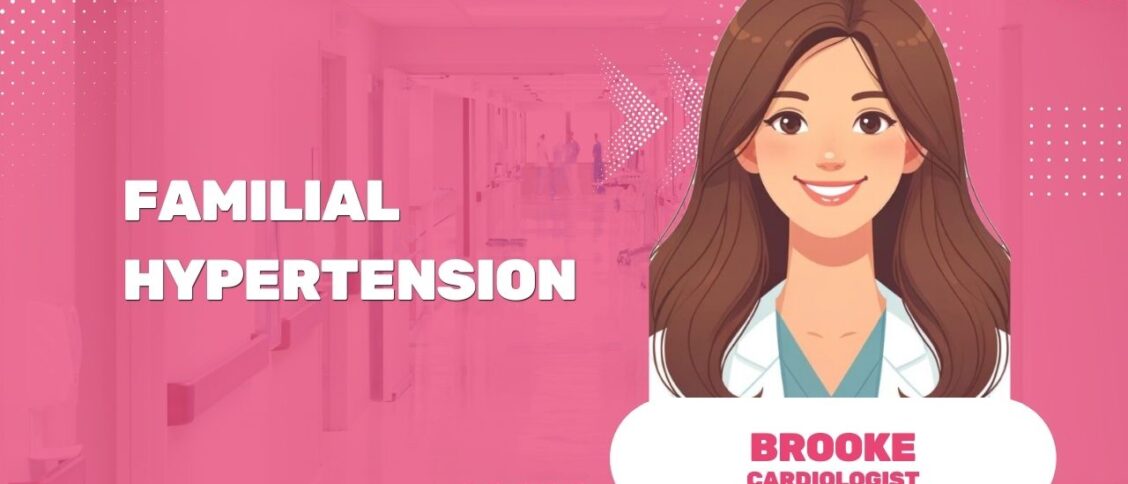High blood pressure, or hypertension, isn’t just a health concern for the individual. It’s a family matter too. Familial hypertension is a type of high blood pressure that runs in families. It’s a silent enemy, often going unnoticed until it’s too late.
In my years of health blogging, I’ve seen how crucial it is to understand familial hypertension. It’s not just about knowing your numbers. It’s about understanding your family history and how it impacts your health.
In this article, I’ll dive deep into the complexities of familial hypertension, shedding light on its causes, effects, and the importance of early detection. We’ll explore the steps you can take to manage it, ensuring that you and your loved ones lead a healthier, happier life.
Familial Hypertension
Familial Hypertension, often acknowledged as a silent killer, is a type of high blood pressure that runs in families. It’s crucial to equip ourselves with knowledge and understanding about this condition as it holds potential health risks that shouldn’t be overlooked.
Taking a tour down your family tree and checking blood pressure regularly play a significant role in early detection of Familial Hypertension. If you come from a lineage that battled hypertension, it’s a wake up call to begin the journey of constant monitoring. This isn’t something to be scared of, instead it offers a beneficial step that could help in managing, if not avoiding, this condition.
Equipped with these facts about Familial Hypertension, it seems only natural to uncover some strategies on how to lower blood pressure. This list isn’t exhaustive, but here are some effective suggestions:
- Stay Active: Get your heart pumping. This helps reduce the heart’s workload, lowering blood pressure.
- Healthy Diet: A diet rich in fruits, vegetables, lean meats, and healthy oils can play a vital role.
- Limit Sodium: Too much salt can lead to water retention, which can increase blood pressure.
- Say No to Stress: Let’s not undermine the power of a calm mind.
- Quit Smoking: Smoking tightens your blood vessels, which in turn, can raise blood pressure.
What is Familial Hypertension?
Understanding Hypertension
Before we jump right into what familial hypertension is, it’s essential to roughly understand hypertension. Hypertension, also known as high blood pressure, occurs when the force of your blood against your artery walls is consistently too high. It’s a bit like turning up the water pressure in a hose – if it’s too intense, the hose may burst. With hypertension, this pressure can result in health concerns such as heart disease or stroke. Observing your own blood pressure is important: do it frequently, and know what the numbers mean. It might sound complicated, but it’s as simple as using a blood pressure monitor and referring to a blood pressure chart.
| Blood Pressure Levels | Systolic (mm Hg) | Diastolic (mm Hg) |
|---|---|---|
| Normal | Less than 120 | Less than 80 |
| Elevated | 120 – 129 | Less than 80 |
| Hypertension Stage 1 | 130 – 139 | 80 – 89 |
| Hypertension Stage 2 | 140 or higher | 90 or higher |
| Hypertensive Crisis | Higher than 180 | Higher than 120 |
The systolic number (upper one) shows how much pressure your blood is exerting against your artery walls when the heart beats. The diastolic (lower one) shows this pressure when the heart is resting between beats. If these numbers lie in the “Hypertension Stage 1” range or above, it’s time to consult a doctor.
Genetic Factors
Now let’s get into the heart of the matter – familial hypertension. This term refers to high blood pressure that appears to run in families. How does that happen? It’s all in the genes – hypertension can be part of the baggage we inherit from our parents. While lifestyle factors like diet, smoking, and exercise certainly influence blood pressure, numerous studies show that there’s also a significant genetic component. If your family history includes high blood pressure, it’s more important than ever to monitor your own pressure and take steps towards lowering blood pressure.
Some methods include:
- Staying active through exercise
- Maintaining a heart-healthy diet
- Limiting sodium intake
- Proper stress management
- Quitting smoking
By keeping these strategies in mind, you can also play a part in breaking this cycle for the future generations of your family. That’s a powerful notion, isn’t it? Remember, it’s less about the cards you’re dealt and more about how you choose to play them. It’s up to us to make the healthy decisions and life adjustments to avoid the risk of hypertension.
Types of Familial Hypertension
When talking about high blood pressure that seemingly runs in families, it’s commonly referred to as familial hypertension. However, there are several distinct types of this condition, each characterized by various features and medical quirks.
Type 1
Type 1 familial hypertension is typically diagnosed in early adulthood, often between the ages of 20 and 40. This type of hypertension is commonly associated with obesity, physical inactivity, and unhealthy dietary habits. It’s generally the most prevalent form of familial hypertension, affecting a substantial percentage of those with a family history of high blood pressure.
With a good blood pressure monitor, early detection and management of type 1 are possible. Changes in lifestyle, including staying active and maintaining a healthy diet, can significantly aid in lowering blood pressure levels.
Note: Always have a look at a blood pressure chart and understand the blood pressure ranges that fall under normal, elevated, and hypertension states.
Type 2
Type 2 familial hypertension is often diagnosed later in life, usually after 40. It’s characterized by insulin resistance and has a high risk of developing into more serious conditions such as heart disease.
Given the later onset, regularly checking blood pressure becomes extremely critical as people age. If you notice an elevated range persistently, don’t delay seeking medical help.
Type 3
Finally, Type 3 familial hypertension identifies those with a strongly genetic, non-modifiable risk. This type typically occurs irrespective of lifestyle factors, dietary habits, or physical activity levels.
As a precaution, even those who maintain an impeccable health regimen should regularly check their blood pressure if their family has a history of hypertension. Becoming familiar with a blood pressure chart and ranges is an excellent proactive measure.
Remember, it’s not about fearing what may come, but about staying aware and ensuring optimal health. Stay vigilant, seek help if needed, and let’s continue our journey to understand more facets of familial hypertension.
Symptoms and Diagnosis
Understanding the signs and symptoms of familial hypertension is vitally important to ensure timely intervention. Let’s delve into some key points that help detect this condition.
High Blood Pressure
As the common symptom among all types of familial hypertension, high blood pressure is often the first sign. However, it’s not always easy to determine. High blood pressure doesn’t usually have visible signs or symptoms. Instead, it’s typically identified by regular checks using a blood pressure monitor.
Family History
Family history serves as a significant factor in the diagnosis of familial hypertension. If there’s a pattern of high blood pressure, obesity, or sedentary behavior in your family, you may have an increased risk.
Notably, types 1 and 3 familial hypertension show a stronger connection with family history.
Medical Tests
For conclusive identification, certain medical tests often constitute the next step after considering blood pressure measurements and family history. Such tests could facilitate in identifying any organ damage that might have occurred due to hypertension.
Typical tests include blood tests, urine tests, electrocardiogram (ECG), and echocardiogram, among others. After all, these detailed examinations significantly aid in not only confirming the diagnosis but also chalking out the course of required treatment.
Establishing a clear understanding of blood pressure ranges and owning a good-quality blood pressure monitor are great steps towards maintaining a proactive stance on your health. Always remember, lowering blood pressure begins with awareness and regular checking. Consistent monitoring combined with necessary medical guidance can potentially keep your health risks at bay.
Let’s keep exploring the fascinating and crucial realm of familial hypertension.
Treatment Options
When dealing with familial hypertension, it’s important to understand the different approaches to control and manage this chronic condition. Treatment usually involves various lifestyle changes, medication, and regular monitoring and management of blood pressure.
Lifestyle Changes
First on our list when it comes to managing familial hypertension are lifestyle changes. In many situations, these adjustments can help reduce high blood pressure levels significantly. Here’s what I suggest:
- Healthy Eating: Following the Dietary Approaches to Stop Hypertension (DASH) plan can significantly decrease blood pressure. This nutritious diet includes fruits, vegetables, lean proteins, and whole grains.
- Regular Exercise: Physical activity, when done regularly, can lower your blood pressure. Aim for at least 150 minutes of moderate activity or 75 minutes of vigorous exercise weekly.
- Limit Alcohol and Quit Smoking: These can increase your blood pressure and damage your heart. Limiting alcohol and quitting smoking can significantly reduce these risks.
Medication
Sometimes, lifestyle changes aren’t enough and medication becomes necessary. You must consult with your healthcare provider for the best suited medication for your condition. Here are some common medications often prescribed for high blood pressure:
| Medication | Purpose |
|---|---|
| Diuretics or “water pills” | Helps the kidneys get rid of excess sodium and water, reducing blood volume. |
| Angiotensin-Converting Enzyme (ACE) inhibitors | Prevents the formation of a hormone called angiotensin II, which normally causes blood vessels to narrow. |
| Calcium channel blockers | Prevent calcium from entering the muscle cells of the heart and arteries, which causes the blood vessels to relax and blood pressure to reduce. |
Monitoring and Management
The last critical aspect of treating familial hypertension is monitoring and managing your blood pressure. Here’s where proper knowledge of blood pressure ranges and owning a reliable blood pressure monitor come in.
To check your blood pressure correctly, make sure to remain calm and seated comfortably before using your monitor.
Preventing Familial Hypertension
Even with a familial predisposition, there are ways to take on the challenge of hypertension. Focusing on maintaining a healthy lifestyle, committing to regular exercise, and employing effective stress-management techniques can make a significant difference.
Healthy Lifestyle Choices
It’s widely accepted that our lifestyle choices have a profound impact on our overall health. When it comes to blood pressure, this holds especially true. The optimal lifestyle choices to consider include:
- Following a balanced, low-sodium diet like the DASH (Dietary Approaches to Stop Hypertension)
- Limiting alcohol intake
- Quitting smoking
Avoiding excess sodium is particularly significant as it directly influences our blood pressure ranges. Regularly checking a blood pressure chart can help track changes over time.
Regular Exercise
In the battle against hypertension, we can’t ignore the importance of Regular Exercise. Regular physical activity can be extremely beneficial in lowering blood pressure. It doesn’t have to be overly strenuous; even simple exercises like walking, cycling, or swimming for 30 minutes a day can make a difference.
Just like a diet, keeping track of exercise progress is beneficial too. It’s recommended to have a weekly exercise plan and stick to it to help manage blood pressure.
Managing Stress
In our fast-paced world, stress is almost inevitable. However, how we deal with it can significantly impact our health, specifically our blood pressure. Mindfulness practices such as yoga, meditation, and deep breathing exercises can aid in stress management.
Additionally, maintaining a proper sleep schedule, being social, and picking up a hobby could not only alleviate stress but also contribute to overall well-being.
In the end, be proactive in monitoring your blood pressure; invest in a blood pressure monitor, understand the readings, know the healthy ranges, and above all else, consult with a healthcare provider regularly. Doing so could mean the length and quality of your life. Stay vigilant, stay healthy.
Conclusion
So, we’ve explored familial hypertension, its implications, and the steps we can take to manage it. Remember, a healthy lifestyle is your strongest defense. It’s about eating right, staying active, and keeping stress at bay. Regular check-ups and understanding your blood pressure readings are equally critical. Don’t underestimate the power of a good night’s sleep either. It’s not just about managing your condition today, but safeguarding your health for the future. Let’s not allow familial hypertension to dictate our lives. Instead, let’s take charge and live healthily.







